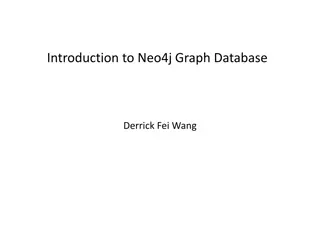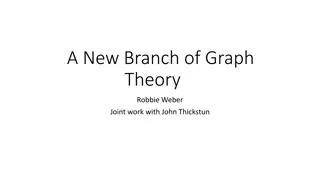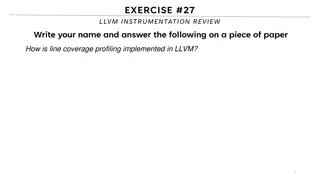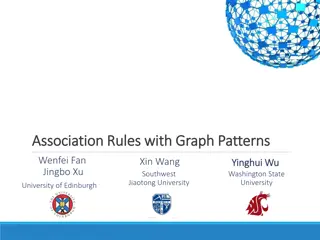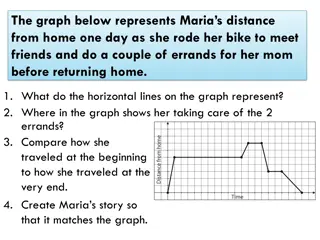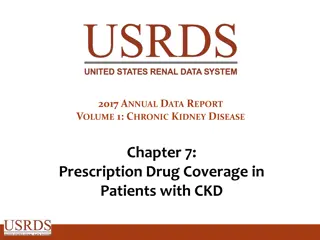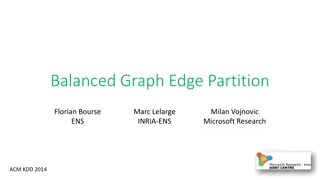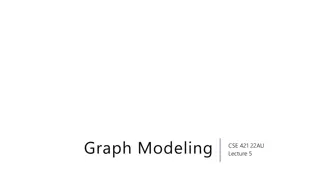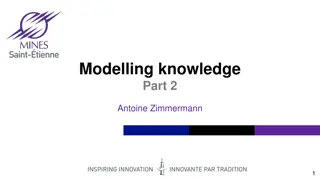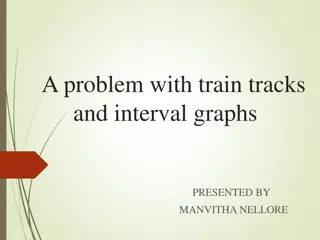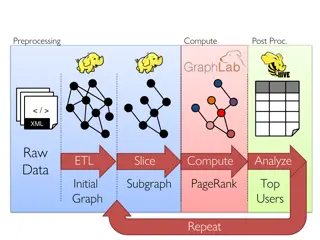
Graph Coverage for Source Code and Control Flow Graphs Overview
Learn about graph coverage for source code including control flow graphs and their common applications. Discover node coverage, edge coverage, loops, and data flow coverage methods with examples. Dive into understanding control flow graphs and their modeling of method executions through nodes and edges with basic blocks. Explore CFG structures for if-statements, loops, and switch cases to enhance your software testing knowledge.
Uploaded on | 3 Views
Download Presentation

Please find below an Image/Link to download the presentation.
The content on the website is provided AS IS for your information and personal use only. It may not be sold, licensed, or shared on other websites without obtaining consent from the author. If you encounter any issues during the download, it is possible that the publisher has removed the file from their server.
You are allowed to download the files provided on this website for personal or commercial use, subject to the condition that they are used lawfully. All files are the property of their respective owners.
The content on the website is provided AS IS for your information and personal use only. It may not be sold, licensed, or shared on other websites without obtaining consent from the author.
E N D
Presentation Transcript
Graph Coverage for Source Code Moonzoo Kim School of Computing KAIST The original slides are taken from Chap. 7 of Intro. to SW Testing 2nd ed by Ammann and Offutt
Overview The most common application of graph criteria is to program source Graph : Usually the control flow graph (CFG) Node coverage : Execute every statement Edge coverage : Execute every branch Loops : Looping structures such as for loops, while loops, etc. Data flow coverage : Augment the CFG defs are statements that assign values to variables uses are statements that use variables 2
Control Flow Graphs A CFG models all executions of a method by describing control structures Nodes : Statements or sequences of statements (basic blocks) Edges : Transfers of control Basic Block : A sequence of statements such that if the first statement is executed, all statements will be (no branches) CFGs are sometimes annotated with extra information branch predicates defs uses Rules for translating statements into graphs 3
CFG : The if Statement if (x < y) { y = 0; x = x + 1; } else { x = y; } 1 x < y x >= y y = 0 x = x + 1 2 3 x = y 4 1 if (x < y) { y = 0; x = x + 1; } x < y y = 0 x = x + 1 x >= y 2 3 4
CFG : The if-Return Statement if (x < y) { return; } print (x); return; 1 x < y x >= y return 2 print (x) return 3 No edge from node 2 to 3. The return nodes must be distinct. 5
Loops Loops require extra nodes to be added Nodes that do not represent statements or basic blocks 6
CFG : while and for Loops 1 x = 0 x = 0; while (x < y) { y = f (x, y); x = x + 1; } dummy node 2 implicitly initializes loop x < y x >= y 1 x = 0 3 4 y =f(x,y) x = x + 1 2 x < y x >= y for (x = 0; x < y; x++) { y = f (x, y); } 3 5 y = f (x, y) 4 x = x + 1 implicitly increments loop 7
CFG : The case (switch) Structure read ( c) ; switch ( c ) { case N : y = 25; break; case Y : y = 50; break; default: y = 0; break; } print (y); read ( c ); 1 c == N default c == Y 2 3 4 y = 25; break; y = 0; break; y = 50; break; 5 print (y); 8
Example Control Flow Stats public static void computeStats (int [ ] numbers) { int length = numbers.length; double med, var, sd, mean, sum, varsum; sum = 0; for (int i = 0; i < length; i++) { sum += numbers [ i ]; } med = numbers [ length / 2 ]; mean = sum / (double) length; varsum = 0; for (int i = 0; i < length; i++) { varsum = varsum + ((numbers [ I ] - mean) * (numbers [ I ] - mean)); } var = varsum / ( length - 1.0 ); sd = Math.sqrt ( var ); System.out.println ("length: " + length); System.out.println ("mean: " + mean); System.out.println ("median: " + med); System.out.println ("variance: " + var); System.out.println ("standard deviation: " + sd); } 9
Control Flow Graph for Stats public static void computeStats (int [ ] numbers) { int length = numbers.length; double med, var, sd, mean, sum, varsum; 1 sum = 0; for (int i = 0; i < length; i++) { sum += numbers [ i ]; } med = numbers [ length / 2 ]; mean = sum / (double) length; i = 0 2 i >= length 3 varsum = 0; for (int i = 0; i < length; i++) { varsum = varsum + ((numbers [ I ] - mean) * (numbers [ I ] - mean)); } var = varsum / ( length - 1.0 ); sd = Math.sqrt ( var ); i < length 4 i++ 5 i = 0 6 System.out.println ("length: " + length); System.out.println ("mean: " + mean); System.out.println ("median: " + med); System.out.println ("variance: " + var); System.out.println ("standard deviation: " + sd); } i < length i >= length 7 8 i++ 10
Control Flow TRs and Test Paths EC 1 Edge Coverage 2 9 TRs A. [ 1, 2 ] B. [ 2, 3 ] C. [ 3, 4 ] D. [ 3, 5 ] E. [ 4, 3 ] F. [ 5, 6 ] G. [ 6, 7 ] H. [ 6, 8 ] I. [ 7, 6 ] Test Path [ 1, 2, 3, 4, 3, 5, 6, 7, 6, 8 ] 3 4 5 6 7 8 11
Control Flow TRs and Test Paths EPC 1 Edge-Pair Coverage 12 TRs Test Paths A. [ 1, 2, 3 ] B. [ 2, 3, 4 ] C. [ 2, 3, 5 ] D. [ 3, 4, 3 ] E. [ 3, 5, 6 ] F. [ 4, 3, 5 ] G. [ 5, 6, 7 ] H. [ 5, 6, 8 ] I. [ 6, 7, 6 ] J. [ 7, 6, 8 ] K. [ 4, 3, 4 ] L. [ 7, 6, 7 ] i. [ 1, 2, 3, 4, 3, 5, 6, 7, 6, 8 ] ii. [ 1, 2, 3, 5, 6, 8 ] iii. [ 1, 2, 3, 4, 3, 4, 3, 5, 6, 7, 6, 7, 6, 8 ] 2 3 4 TP TRs toured sidetrips 5 i A, B, D, E, F, G, I, J C, H Bug detected ii A, C, E, H C, H iii A, B, D, E, F, G, I, J, K, L 6 7 8
Control Flow TRs and Test Paths PPC Prime Path Coverage 1 10 TRs Test Paths A. [ 3, 4, 3 ] B. [ 4, 3, 4 ] C. [ 7, 6, 7 ] D. [ 7, 6, 8 ] E. [ 6, 7, 6 ] F. [ 1, 2, 3, 4 ] G. [4, 3, 5, 6, 7] H. [4, 3, 5, 6, 8] I. [ 1, 2, 3, 5, 6, 7 ] J. [ 1, 2, 3, 5, 6, 8 ] i. [ 1, 2, 3, 4, 3, 5, 6, 7, 6, 8 ] ii. [ 1, 2, 3, 4, 3, 4, 3, 5, 6, 7, 6, 7, 6, 8 ] iii. [ 1, 2, 3, 4, 3, 5, 6, 8 ] iv. [ 1, 2, 3, 5, 6, 7, 6, 8 ] v. [ 1, 2, 3, 5, 6, 8 ] 2 Infeasible Infeasible 3 4 5 sidetrips TP TRs toured Infeasible Infeasible i A, D, E, F, G H, I, J ii A, B, C, D, E, F, G, H, I, J 6 J iii A, F, H J iv D, E, F, I 7 8 v J Minimum # of test paths to cover all TRs? 4
Data Flow Coverage for Source def : a location where a value is stored into memory x appears on the left side of an assignment (x = 44;) x is an actual parameter in a call and the method changes its value x is a formal parameter of a method (implicit def when method starts) x is an input to a program use : a location where variable s value is accessed x appears on the right side of an assignment x appears in a conditional test x is an actual parameter to a method x is an output of the program x is an output of a method in a return statement If a def and a use appear on the same node, then it is only a DU-pair if the def occurs after the use and the node is in a loop 14
Example Data Flow Stats public static void computeStats (int [ ] numbers) { int length = numbers.length; double med, var, sd, mean, sum, varsum; sum = 0; for (int i = 0; i < length; i++) { sum += numbers [ i ]; } mean = sum / (double) length; med = numbers [ length / 2 ]; varsum = 0; for (int i = 0; i < length; i++) { varsum = varsum + ((numbers [ i ] - mean) * (numbers [ i ] - mean)); } var = varsum / ( length - 1.0 ); sd = Math.sqrt ( var ); System.out.println ("length: " + length); System.out.println ("mean: " + mean); System.out.println ("median: " + med); System.out.println ("variance: " + var); System.out.println ("standard deviation: " + sd); } 15
Control Flow Graph for Stats ( numbers ) sum = 0 length = numbers.length 1 i = 0 2 3 i >= length i < length mean = sum / (double) length; med = numbers [ length / 2 ] varsum = 0 i = 0 4 5 sum += numbers [ i ] i++ 6 i >= length i < length var = varsum / ( length - 1.0 ) sd = Math.sqrt ( var ) print (length, mean, med, var, sd) 8 7 varsum = i++ 16
CFG for Stats With Defs & Uses 1 def (1) = { numbers, sum, length } def (2) = { i } 2 3 use (3, 5) = { i, length } use (3, 4) = { i, length } def (5) = { mean, med, varsum, i } use (5) = { numbers, length, sum } 4 5 def (4) = { sum, i } use (4) = { sum, numbers, i } 6 use (6, 8) = { i, length } use (6, 7) = { i, length } def (8) = { var, sd } use (8) = { varsum, length, mean, med, var, sd } 8 7 def (7) = { varsum, i } use (7) = { varsum, numbers, i, mean } 17
Defs and Uses Tables for Stats Edge Use Node Def Use 1 { numbers, sum, length } { i } (1, 2) (2, 3) 2 3 4 5 (3, 4) (4, 3) { i, length } { sum, i } { mean, med, varsum, i } { numbers, i, sum } { numbers, length, sum } (3, 5) { i, length } (5, 6) 6 (6, 7) { i, length } 7 { varsum, i } { varsum, numbers, i, mean } { varsum, length, var, mean, med, var, sd } (7, 6) (6, 8) { i, length } 8 { var, sd } 18
DU Pairs for Stats As defs come before uses in the same basic block (local use), data flow analysis does not use the DU pair variable DU Pairs numbers length med var sd mean sum varsum i (1, 4) (1, 5) (1, 7) (1, 5) (1, 8) (1, (3,4)) (1, (3,5)) (1, (6,7)) (1, (6,8)) (5, 8) (8, 8) (8, 8) (5, 7) (5, 8) (1, 4) (1, 5) (4, 4) (4, 5) (5, 7) (5, 8) (7, 7) (7, 8) (2, 4) (2, (3,4)) (2, (3,5)) (2, 7) (2, (6,7)) (2, (6,8)) (4, 4) (4, (3,4)) (4, (3,5)) (4, 7) (4, (6,7)) (4, (6,8)) (5, 7) (5, (6,7)) (5, (6,8)) (7, 7) (7, (6,7)) (7, (6,8)) defs after use in loop, these are valid DU pairs No def-clear path different scope for i No path through graph from nodes 5 and 7 to 4 or 3 19
DU Paths for Stats DU Paths [ 1, 2, 3, 4 ] [ 1, 2, 3, 5 ] [ 1, 2, 3, 5, 6, 7 ] variable numbers DU Pairs (1, 4) (1, 5) (1, 7) variable mean DU Pairs (5, 7) (5, 8) (5, 7) (5, 8) (7, 7) (7, 8) DU Paths [ 5, 6, 7 ] [ 5, 6, 8 ] [ 5, 6, 7 ] [ 5, 6, 8 ] [ 7, 6, 7 ] [ 7, 6, 8 ] varsum length (1, 5) (1, 8) (1, (3,4)) (1, (3,5)) (1, (6,7)) (1, (6,8)) [ 1, 2, 3, 5 ] [ 1, 2, 3, 5, 6, 8 ] [ 1, 2, 3, 4 ] [ 1, 2, 3, 5 ] [ 1, 2, 3, 5, 6, 7 ] [ 1, 2, 3, 5, 6, 8 ] i (2, 4) (2, (3,4)) (2, (3,5)) (4, 4) (4, (3,4)) (4, (3,5)) (5, 7) (5, (6,7)) (5, (6,8)) (7, 7) (7, (6,7)) (7, (6,8)) [ 2, 3, 4 ] [ 2, 3, 4 ] [ 2, 3, 5 ] [ 4, 3, 4 ] [ 4, 3, 4 ] [ 4, 3, 5 ] [ 5, 6, 7 ] [ 5, 6, 7 ] [ 5, 6, 8 ] [ 7, 6, 7 ] [ 7, 6, 7 ] [ 7, 6, 8 ] med var sd sum (5, 8) (8, 8) (8, 8) (1, 4) (1, 5) (4, 4) (4, 5) [ 5, 6, 8 ] No path needed No path needed [ 1, 2, 3, 4 ] [ 1, 2, 3, 5 ] [ 4, 3, 4 ] [ 4, 3, 5 ] 20
DU Paths for Stats No Duplicates There are 38 DU paths for Stats, but only 12 unique [ 1, 2, 3, 4 ] [ 1, 2, 3, 5 ] [ 1, 2, 3, 5, 6, 7 ] [ 1, 2, 3, 5, 6, 8 ] [ 2, 3, 4 ] [ 2, 3, 5 ] [ 4, 3, 4 ] [ 4, 3, 5 ] [ 5, 6, 7 ] [ 5, 6, 8 ] [ 7, 6, 7 ] [ 7, 6, 8 ] 4 expect a loop not to be entered 6 require at least one iteration of a loop 2 require at least two iteration of a loop 21
Test Cases and Test Paths w.r.t. Loop behavior Test Case : numbers = (2, 10, 15) ; length = 3 Test Path : [ 1, 2, 3, 4, 3, 4, 3, 4, 3, 5, 6, 7, 6, 7, 6, 7, 6, 8 ] DU Paths covered (no sidetrips) [ 4, 3, 4 ] [ 7, 6, 7 ] The two stars that require at least two iterations of a loop 100% node and edge coverage achieved Test Case : numbers = (44) ; length = 1 Test Path : [ 1, 2, 3, 4, 3, 5, 6, 7, 6, 8 ] Additional DU Paths covered (no sidetrips) [ 1, 2, 3, 4 ] [ 2, 3, 4 ] [ 4, 3, 5 ] [ 5, 6, 7 ] [ 7, 6, 8 ] The five stars that require at least one iteration of a loop A bug found Other DU paths require arrays with length 0 to skip loops But the method fails with divide by zero on the statement mean = sum / (double) length; 22
Summary Applying the graph test criteria to control flow graphs is relatively straightforward Most of the developmental research work was done with CFGs A few subtle decisions must be made to translate control structures into the graph Some tools will assign each statement to a unique node These slides and the book uses basic blocks Coverage is the same, although the bookkeeping will differ




